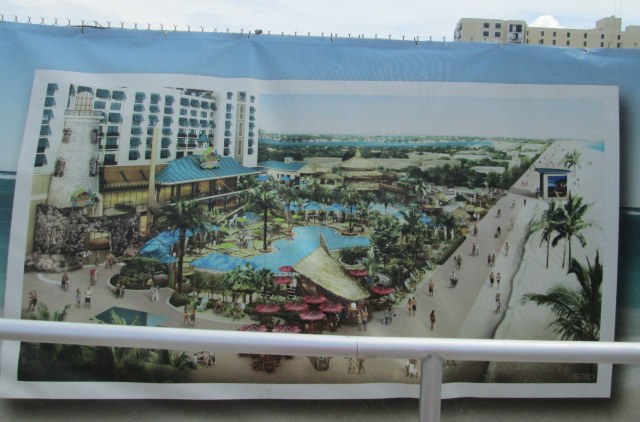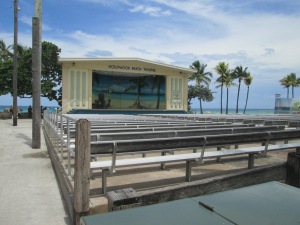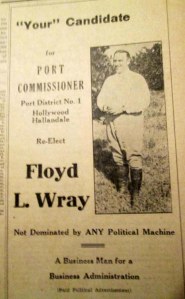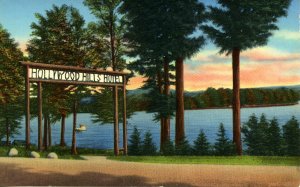Hollywood’s Broadwalk looking north in 1923
Courtesy of the Hollywood Historical Society
Other cities may have appended “beach” to their names, but super-salesman J. W. Young went one better with his poetic description of Hollywood “By-the-Sea.”
Founder’s Day. Hollywood recognizes its founder annually in August, the month of his birth. This year Founder’s Day is August 3, 2014. Joseph W. Young, Jr. was born August 4, 1882 in Seattle, Washington.
Casino Site to Become Margaritaville. On July 8, 1925 the Miami Metropolis Herald wrote that Young and Hollywood announced the grand opening of the Beach Swimming Casino that 4th of July. It was on the Broadwalk just south of Johnson Street (which still had the barge bridge crossing to the mainland). 
Right, Looking west across the Hollywood Casino pool, 1925-26. Note high diving tower, center. Postcard
Left, looking east from the diving tower, with a boating “battle” in progress.
1925-26.
Young built both the Broadwalk and the Casino as means to entertain visitors and draw them to the ocean front, and to stimulate interest in the house lots he was selling on the beach island. The Olympic size saltwater pool with its 3-story diving tower was chiefly a place for water shows, swimming and diving by Olympic athletes, and even little boat races. Hence the viewing stands built on the north and south sides of the main pool. There were also wading pools for small children (see top photo), and surrounding the pools were changing rooms, which we later called cabanas. The Casino was where everyone in Hollywood learned to swim up through the Fifties. 
For example, in July of 1934 the Hollywood Herald ran an ad for the Hollywood Beach Casino offering swimming instruction on Saturdays for children ages 2 to 12. Summer tickets for this instruction were one dollar per month.
Eventually the pool was demolished and that half-block was basically left empty for decades.
Now that has changed, in a big way. Margaritaville is currently under construction.
 Above, artist’s rendering of future Margaritaville, looking north along the Broadwalk. From a poster hung on the fence surrounding the construction at Johnson Street. July 2014.
Above, artist’s rendering of future Margaritaville, looking north along the Broadwalk. From a poster hung on the fence surrounding the construction at Johnson Street. July 2014.
So far, I like it. As you can see, the hotel is set quite far back from the Broadwalk, with several pools in the open area.
 Right, Margaritaville under construction, July 2014. Benches in foreground face the open-air theater.
Right, Margaritaville under construction, July 2014. Benches in foreground face the open-air theater.
So it appears, countering rumors, that the complex will not take over the Broadwalk nor the theater.
 At left, the Broadwalk at Johnson Street, looking south past the Casino, 1926. Postcard.
At left, the Broadwalk at Johnson Street, looking south past the Casino, 1926. Postcard.
At right, the same view, Broadwalk looking south, past the posters on the fence in front of the building under construction, at right. July, 2014.
Visible in the artist’s rendering of future Margaritaville, above, is a small, freestanding structure at the upper right, which presumably is the current Hollywood Beach Theater. In the mid-1920s Young erected a wooden bandstand there, with wood benches, to provide entertainment. This fragile structure did not survive the 1926 hurricane and tidal wave.
This fragile structure did not survive the 1926 hurricane and tidal wave.
Aerial photos on postcards from the 1960s show that the site still remained empty.
In the postcard at right, Johnson Street is the wide vertical road in the center, with shops along its south side, then the remnant of the casino pool. There is no theater or bandstand on the beach.
 Left, Hollywood Beach Theatre at the Broadwalk and Johnson Street today. July 2014.
Left, Hollywood Beach Theatre at the Broadwalk and Johnson Street today. July 2014.
If anyone understood publicity it was J. W. Young. Right from the beginning he set his city apart with the evocative nickname “By-the-Sea.” In fact, he was among the first in Florida to see the value in the warm Atlantic shore. Miami, for example, is on the bay, and even Carl Fisher faced his Miami Beach chiefly toward the bay as well, while other towns in Dade and Broward counties that had ocean frontage in the 1920s didn’t develop them (Deerfield, Pompano, Dania, Hallandale). Fort Lauderdale had its river and sound. You would have to go up to Palm Beach County for a developed ocean front, where Henry Flagler with his usual sense of something special, built his Palm Beach resort on the ocean in the 19th century. So I think it would be another way to set the city apart , to bring back the musical name “Hollywood By-the-Sea.”
More from past Julys. “HOMES IN LAKES SECTION.” This is the title on a series of drawings by Young’s main architects, Rubush & Hunter. These drawings were made for the Meyer Kiser Corporation. There are about 20 designs, in tile, stucco, cast stone. Most are asymmetrical, often with a little tower at one side, moon gates, triple serliana windows, balconies, and urns. The drawings are dated July, 1925. It seemed that home builders could put together their choice of these elements, so their homes would be distinctive while still in keeping with Young’s decree that architecture in this part of his city should conform to his preferred styles that included bungalow, adobe, Spanish Eclectic, Mission Revival, and Moorish.
Hollywood in the Hills, Old Forge, New York. Young died in February of 1934, at only 51 years of age, but right up until his death he was continuing several projects he had begun in New York and the Adirondacks. I discuss Young’s Hollywood Hills in Old Forge, NY on First Lake in the Fulton Chain of Lakes, in my biography Joseph W. Young, Jr. and the City Beautiful. A Biography of the Founder of Hollywood, Florida. 
Young selected this Adirondacks site no doubt as a summer resort for residents of his Hollywood By-the-Sea and of course, anyone else interested. He had the development up and running before his death, having put in a lake shore front road, several cottages, a bath house on First Lake, and the expansive Hollywood Casino built right over the lake for dining and dancing, complete with resident orchestra.
Left, Hollywood Hills Hotel on First Lake at Old Forge in the Adirondacks. About 1932. Postcard.
The Hollywood Hills Hotel was begun before Young died, and barely completed in time for the 4th of July celebration there in that same year.
Right, the Hollywood Hills Hotel was the largest construction made of peeled logs in the eastern U.S. Inside the central rotunda was an impressive octagonal lobby with a huge four-sided rock fireplace, and mezzanine supported by more logs, providing the rustic look of the hunting lodge, so popular then.
Left, Cars pack the open spaces around the Hollywood Hills Casino on First Lake, peaked roof at upper left in photo, as hundreds of invitees arrive for the 4th of July, 1934. From “Tomorrow” Young Companies Newsletter.
Invited guests at the opening of the Hollywood Hills Hotel included Jessie Young, J. W.’s widow, son William and son J. W. Young called Tonce and his wife, also Oscar Johnson, hotel manager, who also managed the Hollywood Beach Hotel during its winter seasons.
If you were excited about all the 1930s cars pictured above, see this ad in the July, 1934 Hollywood Herald for 1924 to 1928 models. The most expensive, a 1928 Chevy Sport Coupe for $75. The cheapest: a 1926 Ford Touring at $20! Eat your heart out, antique car buffs!
FLAMINGO GROVES
Looking to the future of Hollywood during the depths of the Great Depression were the founders of the very successful Flamingo Groves out in Davie (now maintained as Flamingo Gardens). The two Hollywood men were Floyd L. Wray and Clarence Philip Hammerstein, and the third was Davie grove specialist Frank Stirling. 
Left, C. Philip Hammerstein in “Who’s Who in Hollywood” in the “Hollywood Herald” in 1934. In 1935 the Hammersteins built the house at 1520 Polk Street, now on the National Register of Historic Places, maintained by the Hollywood Historical Society.
In June-July of 1934 they ran an ad to announce their summer harvest period, and soon after, Floyd Wray wrote a column about the need for a citrus packing house in Broward County since Broward’s orange crop was extensive, but the fruit had to be trucked to an “adjoining county” to be shipped north. Wray wanted to see a packing house capable of handling at least one thousand boxes per day, and a pre-cooling plant with a minimum capacity of 5,000 boxes, preferably near Port Everglades. These plants, said Wray, would employ 80-100 people during the summer season when jobs were hard to find. Shortly thereafter Wray ran for one of the seats on the Port Commission, which he won.
crop was extensive, but the fruit had to be trucked to an “adjoining county” to be shipped north. Wray wanted to see a packing house capable of handling at least one thousand boxes per day, and a pre-cooling plant with a minimum capacity of 5,000 boxes, preferably near Port Everglades. These plants, said Wray, would employ 80-100 people during the summer season when jobs were hard to find. Shortly thereafter Wray ran for one of the seats on the Port Commission, which he won.
THE NAVY COMES TO HOLLYWOOD IN WW II
In July, 1942, following Pearl Harbor, US Naval officers began to arrive in Hollywood to convert the large hotel on the 3rd, most western circle to a naval gunnery training school. (It was then the winter quarters of Riverside Military Academy.) The building had been erected by J. W. Young in 1925 as his original Hollywood Hills Inn.
The Gunners school left Hollywood two years later,in July, 1944, transferring to the Embry Riddle school in Miami.
Right, Rear Admiral Andrew C. McFall of the Seventh Naval District, addresses graduates of Hollywood’s Naval Air Gunnery School in 1944.
THE REC
In July of 1944 the youth recreation center, called “The Rec” was dedicated. More on this later, but any memories–and photos!–of the Rec that you would like to share will be most welcome.
MID-CENTURY MODERN – GONE
 A few years ago the Members Newsletter did a survey of historic buildings along US 1 from Young Circle north to Sheridan Street. This small fast-food restaurant, a delightful exemplar of the postwar exuberance of Fifties Mid-century Modern was included. And in recent weeks there have been beautifully-illustrated articles on Mi-Mo buildings in both Fort Lauderdale and Miami Beach, where there is interest in saving examples of this inventive Florida architecture from mid-20th century. Not so in Hollywood, apparently. This little gem, most recently Papa John’s, could have been re-imagined as an entrance lobby for the high-rise condos planned for the site. But sad to say. it’s gone.
A few years ago the Members Newsletter did a survey of historic buildings along US 1 from Young Circle north to Sheridan Street. This small fast-food restaurant, a delightful exemplar of the postwar exuberance of Fifties Mid-century Modern was included. And in recent weeks there have been beautifully-illustrated articles on Mi-Mo buildings in both Fort Lauderdale and Miami Beach, where there is interest in saving examples of this inventive Florida architecture from mid-20th century. Not so in Hollywood, apparently. This little gem, most recently Papa John’s, could have been re-imagined as an entrance lobby for the high-rise condos planned for the site. But sad to say. it’s gone.
GREAT SOUTHERN HOTEL
Readers might also wish to know that J. W. Young’s second-built hotel, the Great Southern Hotel on the corner of Hollywood Boulevard and the west side of Young Circle, is now mostly surrounded by a construction fence. On a positive note, this gives the interested architecture historian the opportunity to view this 1924 hotel designed by Martin L. Hampton of Miami from all sides. Of particular interest is the east facade, where the two arms of the U-shaped structure are clearly visible.
 Top, East facade of Great Southern Hotel, by Martin L. Hampton in 1924
Top, East facade of Great Southern Hotel, by Martin L. Hampton in 1924
July, 2014
Bottom, Casa Blanca Hotel designed by Rubush & Hunter for J. W. Young in 1925.
Postcard
Curiously, the later Casa Blanca Hotel, designed by different architects, has an almost identical footprint. As a Hollywood native, I can guess that this design opened the largest number of rooms to the prevailing Trade Winds, which were the airconditioning of the day, up through the 1950s.
Early photos of the Great Southern Hotel show that the main entrance was originally on the northwest corner, at the Boulevard and 19th Avenue. Perhaps this entrance led into the ballroom, whose location I haven’t identified.

Great Southern Hotel, designed by Martin L. Hampton for J. W. Young, 1924, with 100 rooms and a ballroom. Postcard, Hollywood Historical Society
Right, early tinted postcard of Young’s Great Southern Hotel showing original entrance on NW corner.
Bottom, same angle today. In the Fifties there was an upscale ladies’ dress shop at that NW corner of the hotel.
So, come if you can this next Sunday, August 3, to the Hollywood Historical Society, where I’ll be giving a PowerPoint presentation starting at 2:00 pm.
PLEASE NOTE: Hollywood, Florida is NOT in California. The Florida city, named in 1920, was NOT named for the Los Angeles development that later became the movie capital. J. W. Young was not thinking of movies, but if he had, he might have chosen “Long Beach” where he lived from 1902-16 when Long Beach WAS the silent movie capital. The map that appears was attached by WordPress. Please ignore it.












Reblogged this on FLORIDA'S HOLLYWOOD: HISTORY and PEOPLE.
Is the Adirondack resort still open?
We enjoyed your presentation on Founder’s Day 2014 and appreciate you for sharing your studies. It is wonderful to learn more about my husband’s birthplace and our beautiful town, Hollywood By the Sea.
Thank you,
Sean and Candace R. Wagner